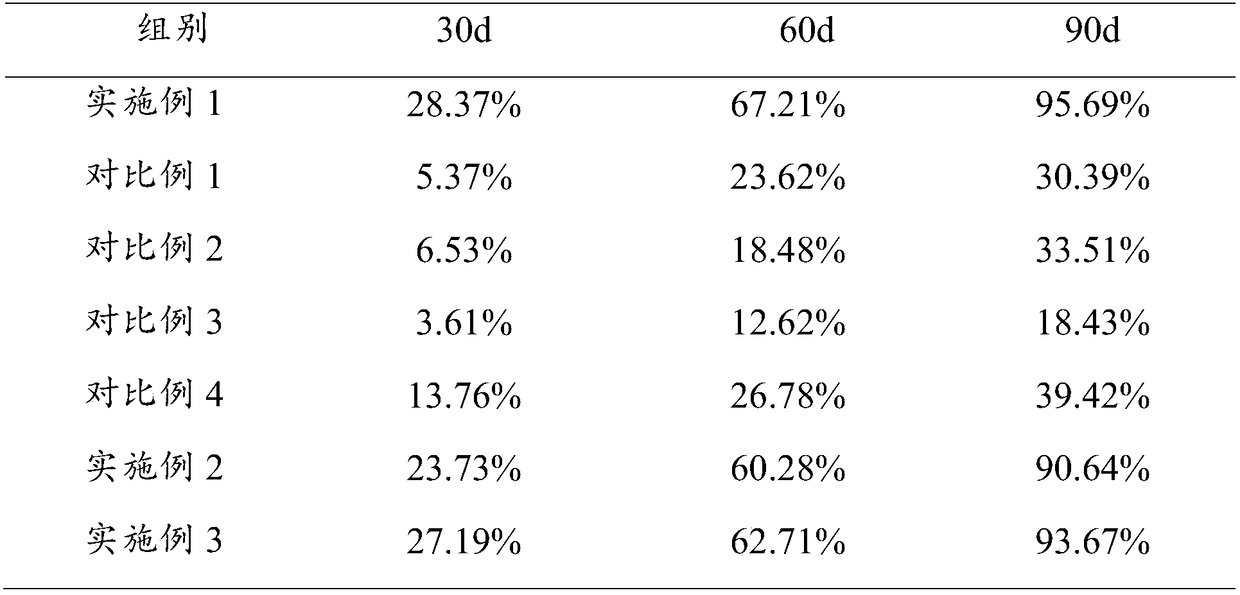Polycyclic aromatic hydrocarbon contaminated soil remediation material and preparation method thereof
A technology for polluted soil and remediation materials is applied in the field of polycyclic aromatic hydrocarbon-contaminated soil remediation materials and their preparation, which can solve the problems of high remediation cost and huge amount of waste water, and achieve the effects of simple preparation method, shielding interference and mild working conditions.
- Summary
- Abstract
- Description
- Claims
- Application Information
AI Technical Summary
Problems solved by technology
Method used
Image
Examples
Embodiment 1
[0031] A polycyclic aromatic hydrocarbon contaminated soil remediation material, consisting of the following components in parts by weight:
[0032] 75 parts of diatomite, 75 parts of peat soil, 1 part of humic acid, 65 parts of corn cob, 35 parts of nutrients, 0.0025 parts of surfactant, 0.025 parts of oxidant, 0.0025 parts of compound microbial agent;
[0033] Nutrients are composed of rice bran, (NH 4 ) 2 HPO 4 , urea, superphosphate and plant ash;
[0034]Rice bran, (NH 4 ) 2 HPO 4 The mass percentages of urea, superphosphate and plant ash in the nutrients are: rice bran 15%, (NH 4 ) 2 HPO 4 2%, urea 1%, superphosphate 3%, plant ash balance;
[0035] Described surfactant is the mixture of anionic surfactant and nonionic surfactant, and the weight ratio of described anionic surfactant and nonionic surfactant is 1:2; Anionic surfactant is sodium lauryl sulfate (SDS); the nonionic surfactant is Triton X-100.
[0036] The oxidizing agent is sodium persulfate activat...
Embodiment 2
[0045] A polycyclic aromatic hydrocarbon contaminated soil remediation material, consisting of the following components in parts by weight:
[0046] 50 parts of diatomite, 50 parts of peat soil, 0.5 parts of humic acid, 40 parts of corn cob, 10 parts of nutrients, 0.001 part of surfactant, 0.02 part of oxidant, 0.001 part of compound microbial agent;
[0047] Nutrients are composed of rice bran, (NH 4 ) 2 HPO 4 , urea, superphosphate and plant ash;
[0048] The rice bran, (NH 4 ) 2 HPO 4 The mass percentages of urea, superphosphate and plant ash in the nutrients are: rice bran 10%, (NH 4 ) 2 HPO 4 1.5%, urea 0.5%, superphosphate 2%, plant ash balance;
[0049] Surfactant is the mixture of anionic surfactant and nonionic surfactant, and the weight ratio of described anionic surfactant and nonionic surfactant is 1:2; Anionic surfactant is sodium dibutyl naphthalene sulfonate; The nonionic surfactant is Triton X-305.
[0050] The oxidizing agent is potassium hydrogen p...
Embodiment 3
[0059] A polycyclic aromatic hydrocarbon contaminated soil remediation material, consisting of the following components in parts by weight:
[0060] 100 parts of diatomite, 100 parts of peat soil, 2 parts of humic acid, 80 parts of corn cob, 50 parts of nutrients, 0.005 parts of surfactant, 0.05 parts of oxidant, and 0.005 parts of compound microbial agent;
[0061] Nutrients are composed of rice bran, (NH 4 ) 2 HPO 4 , urea, superphosphate and plant ash;
[0062] The rice bran, (NH 4 ) 2 HPO 4 The mass percentages of urea, superphosphate and plant ash in the nutrients are: rice bran 20%, (NH 4 ) 2 HPO 4 2.5%, urea 1.5%, superphosphate 4%, plant ash balance;
[0063] Surfactant is the mixture of anionic surfactant and nonionic surfactant, and the weight ratio of described anionic surfactant and nonionic surfactant is 1:2; Anionic surfactant is sodium lauryl sulfate; Nonionic surfactant The ionic surfactant was Brij 35.
[0064] Oxidizing agent is a kind of in Fenton...
PUM
 Login to View More
Login to View More Abstract
Description
Claims
Application Information
 Login to View More
Login to View More - R&D
- Intellectual Property
- Life Sciences
- Materials
- Tech Scout
- Unparalleled Data Quality
- Higher Quality Content
- 60% Fewer Hallucinations
Browse by: Latest US Patents, China's latest patents, Technical Efficacy Thesaurus, Application Domain, Technology Topic, Popular Technical Reports.
© 2025 PatSnap. All rights reserved.Legal|Privacy policy|Modern Slavery Act Transparency Statement|Sitemap|About US| Contact US: help@patsnap.com

